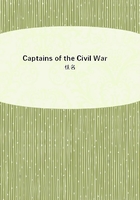
第66章 GETTYSBURG: 1863(2)
Throwing his left forward (under Ewell) in the Shenandoah Valley he had driven Milroy out of Winchester on the fourteenth of June and next day secured a foothold across the Potomac. Then the rest of his army followed. It was so much stretched out (to facilitate its food supply) that Lincoln again wished to strike it at any vulnerable spot. But the Cabinet in general (and Stanton in particular) were still determined that the Union army should be their passive shield, not their active sword. On the twenty-fourth Ewell was already beginning to semicircle Gettysburg from the Cumberland Valley. On the twenty-eighth, the day on which Meade succeeded Hooker in the Federal command, the Confederate semicircle, now formed by Lee's whole army, stretched from Chambersburg on the west, through Carlisle on the north, to York on the east; while the massed Federals were still in Maryland, near Middletown and Frederick, thirty miles south of Gettysburg, and only forty miles northwest of nervous Washington.
Hooker's successor, George G. Meade, was the fifth defender of Washington within the last ten months. Luckily for the Union, Meade was a sound, though not a great, commander, and his hands were fairly free. Luckily again, he was succeeded in command of the Fifth Corps by George Sykes, the excellent leader of those magnificent regulars who fought so well at Antietam and Second Manassas. The change from interference to control was made only just in time at Washington; for three days after Meade's free hand began to feel its way along the threatened front the armies met upon the unexpected battlefield of Gettysburg.
Lee in Pennsylvania was in the midst of a very hostile population and facing superior forces which he could only defeat in one of two difficult ways: either by a sudden, bewildering, and unexpected attack, like Jackson's and his own at Chancellorsville, or by an impregnable defense on ground that also favored a victorious counter-attack and the subsequent crushing pursuit. But there was no Jackson now; and the nature of the country did not favor the bewildering of Federals who were fighting at home under excellent generals well served by a competent staff and well screened by cavalry. So the "fog of war"was quite as dense round Lee's headquarters as it was round Meade's on the first of July, when Lee found that his chosen point of concentration near Gettysburg was already occupied by Buford's cavalry, with infantry and some artillery in support.
The surprise--and no very great surprise--was mutual. The Federals were found where they could stand on their defense in a very strong position if the rest of their army could come up in time. And Lee's only advantage was that, having already ordered concentration round the same position, he had a few hours' start of Meade in getting there.
Each commander had intended to make the other one attack if possible; and Meade of course knew that Lee, with inferior numbers and vastly inferior supplies, could not afford to stay long among gathering enemies in the hostile North without decisive action. The Confederates must either fight or retreat without fighting, and make their choice very soon. So, when the two armies met at Gettysburg, Lee was practically forced to risk an immediate action or begin a retreat that might have ruined Confederate morale.
Gettysburg is one of those battles about which men will always differ. The numbers present, the behavior of subordinates, the tactics employed, were, and still are, subjects of dispute. Above all, there is the vexed question of what Lee should or should not have done. We have little space to spare for any such discussions. We can only refer inquirers to the original evidence (some of which is most conflicting) and give the gist of what seems to be indubitable fact. The numbers were a good seventy thousand Confederates against about eighty thousand Federals. But these are the approximate grand totals; and it must be remembered that the Confederates, having the start, were in superior numbers during the first two days. On each side there was an aggrieved and aggrieving subordinate general, Sickles on the Federal side, Longstreet on the other. But Sickles was by far the less important of the two. In tactics the Federals displayed great judgment, skill, and resolution. The Northern people called Gettysburg a soldiers' battle; and so, in many ways, it was; for there was heroic work among the rank and file on both sides. But it most emphatically was not a soldiers' battle in the sense of its having been won more by the rank and file than by the generals in high command; for never did so many Federal chiefs show to such great advantage. No less than five commanded in succession between morning and midnight on the first day, each meeting the crisis till the next senior came up. They were Buford, Reynolds, Howard, Hancock, Meade. Hunt also excelled in command of the artillery; and this in spite of much misorganization of that arm at Washington. Warren was not only a good commander of the engineers but a good all-round general, as he showed by seizing, on his own initiative, the Little Round Top, without which the left flank could never have been held.
Finally, there is the great vexed question of what Lee should or should not have done. First, it seems clear that (like Farragut and unlike Grant and Jackson) he lacked the ruthless power of making every subordinate bend or break in every time of crisis:
otherwise he would have bent or broken Longstreet. Next, it may have been that he was not then at his best. Concludingly, it may be granted to armchair (and even other) critics that if everything had been something else the results might not have been the same.